State of Nashville: As economy thrives, residents struggle with health, housing, prosperity
Median income gains in Nashville lag peer cities, prenatal care is declining in nearly all Middle Tennessee counties, health insurance coverage has dropped and the percentage of residents living below the poverty line is on the rise.
New data released by the Nashville Area Chamber of Commerce in its annual Vital Signs report comes in stark contrast to the steady stream of economic wins the city has experienced in the past year: record low unemployment rates, expanded GDP and the recruitment of big name companies and organizations including Amazon, Alliance Bernstein, Ernst & Young and Major League Soccer.
While business headlines point to prosperity, many residents are not feeling the gains, based on data gathered over the past decade. Both the Nashville and Clarksville areas face increasing challenges in housing, health, education and infrastructure, in spite of — or because of — their rapid growth.
“A lot of the challenge has to do with not keeping up with critical infrastructure,” Ralph Schulz, CEO of the chamber, said. “In a lot of ways, we are now bumping up on what those challenges can mean to our future prosperity.”
Income, education
Across all levels of education in the Nashville area, the percentage of those below the poverty line has increased between 2007 and 2016, even as unemployment rates have dropped across the board. More than 22 percent of Davidson County children live in poverty and more than half of the region’s counties saw an increase in the percentage of students participating in a free or reduced lunch plan in the past decade.
More recent data shows an improved trajectory. From 2014 to 2017, Nashville poverty rates have declined each year, dropping from about 15 percent to 11 percent, according to chamber officials.
Education is strongly linked to poverty rates and income levels, with 24 percent of those in the Nashville area who lack a high school diploma living in poverty, compared to 11 percent for those who graduated.
Compared to the nation, Nashville has a greater percentage of individuals without a high school diploma — 9.6 percent to 4.5 percent — but it also has a greater percentage of those with a bachelors, graduate or professional degree.
In-migration, which contributed to 70 percent of the region’s growth in 2017, is contributing to gains in educational obtainment. Among those moving to the Nashville area from other states, nearly half have a bachelor’s degree or higher. Of those moving from another country, about 58 percent have those credentials. That compares to between 33 percent to 36 percent among those already in the Nashville area.
Tennessee has sought to boost education levels in recent years with initiatives such as Tennessee Promise, Drive to 55, Labor Education Alignment Program and Tennessee Reconnect Act.
Cost of living
In 2009, Nashville ranked below peer cities in cost of living, but by 2017 the area jumped above Columbus, Indianapolis, Charlotte and Raleigh. Meanwhile, median income gains are lagging. Median household income increased 5.3 percent, or by $3,042, between 2006 and 2016, but Nashville lagged many of its peer cities in income gains. Clarksville’s median income declined in that period.
“The change in wage growth, salary growth coming out of the Great Recession was a relatively modest change compared to previous business cycles,” Garrett Harper, vice president of research for the chamber, said.
Health
While Nashville is known for its health care expertise, the city exceeds the national average in the percentage of those lacking health insurance. In Nashville, 9.5 percent of residents lack health insurance, compared to 8.7 percent nationally.
In 2016, 46 percent of employers offered health insurance, down from 69 percent in 2006. Other than Charlotte, Nashville had the most dramatic decline among peer cities in the percentage of employers dropping coverage.
From 2012 to 2016, the percentage of expectant mothers with adequate prenatal care, defined by the number of doctor visits during pregnancy, dropped in every Middle Tennessee county except Dickson and Montgomery. In Sumner and Cannon counties, the percentage fell by close to 11 percent.
“Good health starts with prenatal care and only about half of the infants born in the Nashville region have received adequate prenatal care,” the report said.
After birth, many Nashville-area children lack health care. Nashville has had significantly higher numbers of children without health insurance compared to peer cities in recent years. About 13,000 Nashville children lacked health insurance in 2016, compared to fewer than 5,000 in Raleigh, Austin, Cleveland and Seattle.
State lawmakers have rejected efforts to expand Medicaid in recent years, even as Gov. Bill Haslam proposed expansion plans. During his campaign, Gov.-elect Bill Lee said he would oppose Medicaid expansion and described the existing program as “fundamentally flawed.”
In Davidson County, more than 35 percent of students in public schools are obese. In Hickman, Smith, Maury, Robertson, Rutherford and Cannon, the percentage exceeds 40. The long-term costs of obesity include hospitalization, pharmaceutical expenses and work productivity losses, according to the report.
“It’s impacting our employers’ ability to get employees who can be there and be fully present,” Jennifer Carlat, the chamber’s chief policy officer said. “The labor market is tight enough that we are looking at all of these issues because they are important to all of our members.”
Housing, transportation costs
Nashville-area residents are increasingly cost-burdened, spending more than half their income on housing and transportation.
In Nashville, the median cost of housing increased by 54 percent from 2008 to 2018, climbing to $246,500 from $159,800. While Nashville offers competitive wages compared to the national average, residents are increasingly spending a majority of their earnings on housing and transportation, according to the report.
At issue is the available inventory, which has not caught up with demand, chamber officials said.
“The overall cost of living in the region remains lower than the national average,” Schulz said. “The increased cost of living, especially as it relates to housing, due to increased demand outpacing supply, is one of the most common challenges attributed to our growth.”
The cost of infrastructure needs in Davidson County alone totaled $5.7 billion for nearly 690 projects, including those related to education, transportation and health. Tennessee received “C” or lower grades on its inland waterways, school facilities, transit, drinking water and wastewater infrastructure.
In recent years, the chamber has featured costs of commuting and congestion in its Vital Signs report. The chamber-backed Let’s Move Nashville initiative to fund $5 billion in public transportation upgrades under a plan called nMotion failed to gather Davidson County voter support in May 2018. Chamber officials said the next proposal could be created between 2022 and 2024.
“The referendum, when it failed, it said Davidson County wasn’t ready to put dedicated funding to this,” Carlat said. “The nMotion plan is still the plan, but now they know they have a constrained budget they have to implement that plan through. The next few years are going to be about, what are all the ways we can squeeze more efficiency from the system we have?”
As infrastructure projects pile up, the region’s population is growing. From 2007 to 2017, the Nashville area’s population grew by 25 percent, or 400,000 people, to 1.9 million people. In 2017, the area grew by 94 people a day, the chamber reported, citing U.S. Census data.
Nashville’s growth rate was ranked behind Charlotte, Austin and Raleigh.
“Our population growth exceeded what we were anticipating in the mid-2000s,” Harper said. “(We’ve) seen a resurgence of migration in the period since the Great Recession nationally and particularly here it has contributed to the population growth.”
[Read more at the Tennessean]


